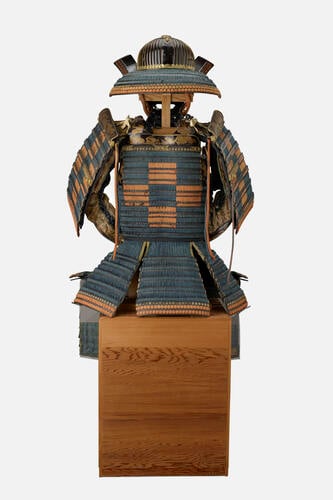-
1 of 253523 objects
Armour (dōmaru) 1580 - 1610
Iron, gilt-copper alloy, shakudō, lacquer, silk, horsehair, deerskin | 161.0 x 72.0 x 70.5 cm (whole object) | RCIN 71611

Iwai Yozaemon (active 1585-1610)
Armour (dōmaru) 1580 - 1610

Iwai Yozaemon (active 1585-1610)
Armour (dōmaru) 1580 - 1610





-
This splendid and understated armour was sent to James I of England by Tokugawa Hidetada, third son of Tokugawa Ieyasu, who ruled as the second shōgun of the Tokugawa dynasty from 1605 to 1623. Some sources have suggested that the armour may once have been owned by Takeda Katsuyori (1546 – 82), a daimyō who had fought, and lost, against Tokugawa Ieyasu at the Battle of Tenmokuzan in 1582.
The armour is of the body-wrapped (dōmaru) type, which hinges around the body and fastens on the right. The ‘pumpkin-shaped’ helmet (akodanari kabuto) is signed by Iwai Yozaemon, one of the main armourers to the ruling Tokugawa family. Armours by Iwai Yozaemon in other European royal collections indicate that this was a popular diplomatic gift from the Tokugawa family, easily available from a regular and reliable source.
The helmet has a very wide, almost flat neck guard (shikoro), small turn-backs (fukikaeshi) and visor (mabizashi) decorated in gold lacquer with stylised clouds. The akodanari helmet has prominent vertical rivet lines and is lacquered black. A raised area at the back of the helmet bowl may have been designed to accommodate the chonmage, the samurai hairstyle which consisted of a shaved pate with the hair oiled and tied at the back of the head in a queue. This distinctive form of helmet was extremely popular during the Muromachi period (1392–1573) and the traditional style would have appealed to the Tokugawa family who were conservative in their tastes. The face-mask (sōmen) has a fearsome appearance, although the whiskers have possibly been trimmed over the years.
Much of the armour is laced in red and blue silk in a chequerboard pattern. The lamellae (kozane) are individual pieces of iron lacquered and laced together – a technique known as hon-kozane (‘true’ kozane), which creates a more flexible armour.
Continuing the conservative style, the shoulder guards (sode) are very large for an armour of this period. The solid iron upper areas of the cuirass (dō) are decorated with gold lacquer dragons whose red lacquer tongues chase stylised clouds, possibly symbolising the Buddhist pearl of enlightenment, on a black lacquer ground. The rims (fukurin) and other metal fittings are of engraved and pierced shakudō and gilt-copper alloy. Interestingly, the small fittings to secure the cuirass have a discreet motif of a paulownia (kiri) leaf, an imperial symbol later adopted by the Tokugawa family. The sleeves (kote) are decorated in a similar fashion and have fine, though faded, silk with auspicious motifs and areas of iron mail. The greaves (suneate) are decorated with further stylised clouds in gold lacquer on black.
Text adapted from Japan: Courts and Culture (2020).Provenance
Sent to James I by Shōgun Tokugawa Hidetada, 1613
This is one of the ‘two varnished armours’ given to Captain John Saris of the East India Company at Edo on 19 September 1613. Saris returned to Plymouth with the gifts in September 1614, but no account of their delivery to James I survives. The pair were almost certainly the first Japanese armours to arrive in Britain. By the mid-seventeenth century, they appear to have been separated, for only one was recorded at the Tower of London in 1660. The present armour was stored in a lacquer box in the Armoury at St James’s Palace, where it was inventoried in 1649–51 by the Commonwealth government for the posthumous sale of Charles I’s possessions. At that time, it was described as an ‘Indian Armor’ and purchased by Major Bas on 23 October 1651 for £10.
Following the Interregnum, the armour was returned to the Royal Collection, but confusion about both pieces’ provenance abounded. The armour at the Tower was for example described in 1662 as a present to Charles II ‘from the Emperor Mougul’, in India. As late as 1916, the present armour was confused with another in the Royal Armouries which had in fact been given to Philip II of Spain in 1585. At that time, it was in reality mounted on the wall of the Grand Vestibule at Windsor Castle, with other Japanese items from the Royal Collection.
In 1857, a Japanese armour was lent by Queen Victoria to the Manchester Art Treasures exhibition, where it formed part of the display in the 'Indian Court'. A contemporary photograph suggests that it was this armour, rather than its counterpart from 1613, given the shape of the helmet and the absence of protruding metal 'horns' (kuwagata) - see ‘The Indian Court’ by Phillip Henry Delamotte, 1857. -
Creator(s)
(nationality)Acquirer(s)
-
Medium and techniques
Iron, gilt-copper alloy, shakudō, lacquer, silk, horsehair, deerskin
Measurements
161.0 x 72.0 x 70.5 cm (whole object)
Category
Object type(s)
Place of Production
Japan